This 30-minute Low FODMAP Pad Thai with Shrimp is a Thai restaurant-inspired dish featuring rice noodles, shrimp, a simple sauce, and FODMAP-friendly amounts of cabbage and green bell peppers.
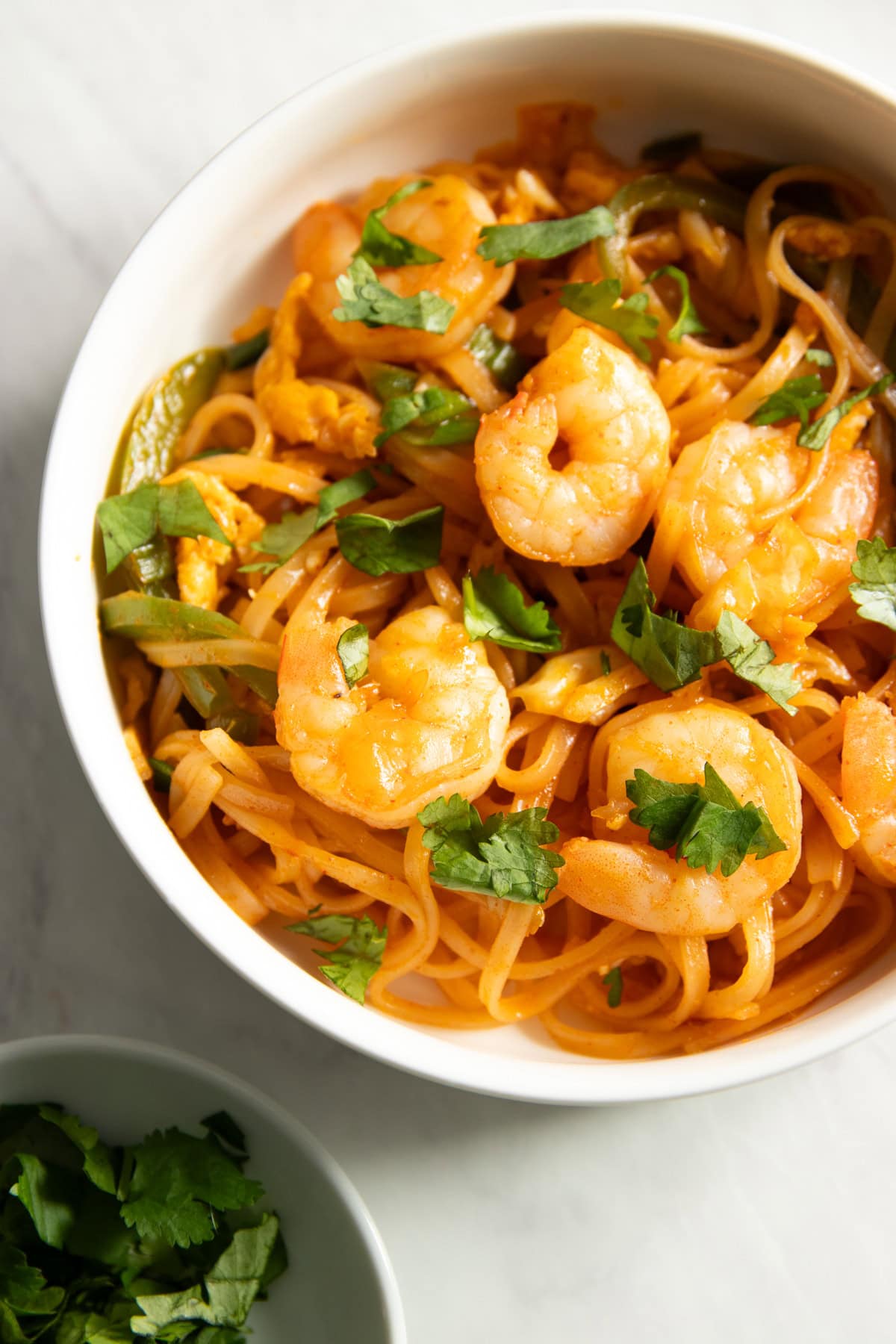
I published the first iteration of this recipe in 2018 after taking a fantastic Thai cooking class at Sawatdee in the Twin Cities from the restaurant's founder, Supenn Harrison.
She taught me how to prepare a handful of Thai recipes and layer ingredients to achieve a harmonious balance of sweet, salty, sour, and spicy flavors—quintessential of many Thai and other Southeast Asian dishes.
Since then, Monash University has retested and changed the FODMAP status and low FODMAP serving sizes of some of the ingredients I originally used. I have modified and updated the recipe to reflect these changes.
Although delicious and flavor-packed, Pad Thai, which we find in many restaurants, often contains higher FODMAP ingredients such as onion and garlic.
While many versions of Pad Thai contain tamarind (and some may call it essential to the dish), Supenn showed us a version of Pad Thai that did not use tamarind. Her method inspired this low-FODMAP Pad Thai recipe.
Ingredients
To make this low FODMAP Pad Thai, be sure to add these ingredients to your shopping list:
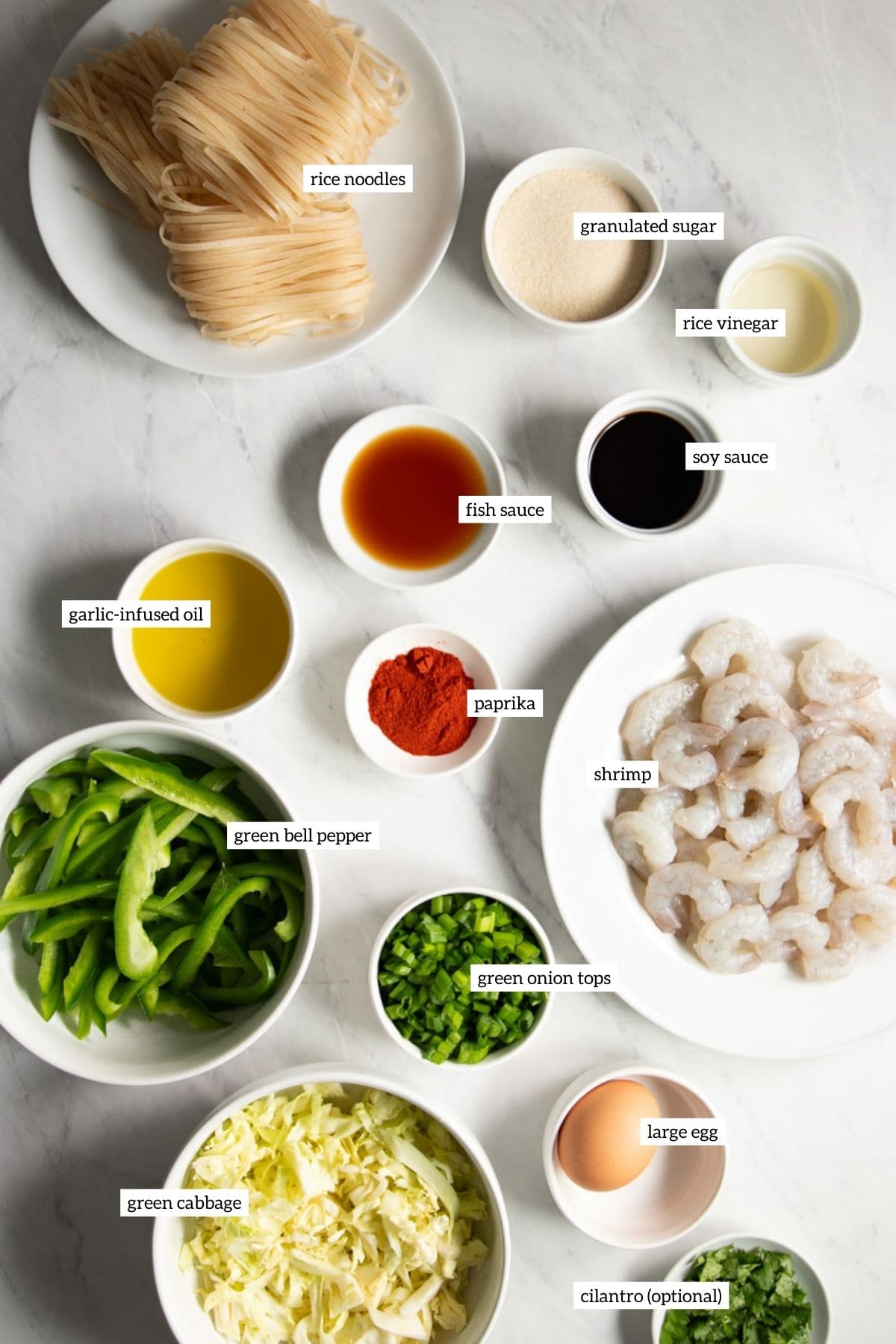
- Rice noodles - 8 ounces uncooked
- Granulated sugar - ¼ cup
- Plain rice vinegar - 2 tablespoons
- Reduced-sodium soy sauce (or tamari for gluten-free) - 2 tablespoons
- Fish sauce - 1 tablespoon
- Ground paprika - 2 teaspoons
- Garlic-infused olive oil - 2 tablespoons + 1 teaspoon
- Green bell pepper - 1 medium
- Green cabbage - 1.5 cups shredded
- Uncooked medium or large shrimp - 1 pound (454 grams)
- Green onion tops (green parts only) - ½ cup sliced
- Egg - 1 large
- Cilantro - optional garnish
Low FODMAP Notes
In this section, I share information for ingredients that are either frequently asked about or have suggested serving sizes to remain low FODMAP. We each have unique tolerance levels and nutritional needs. Please listen to your body (and, if possible, work with a FODMAP-trained dietitian) to determine what is best for you. For more low FODMAP serving size info, please refer to the Monash FODMAP app and FODMAP Friendly website or app.
Rice noodles - A low FODMAP serving is up to 1 cup or 220 grams of cooked noodles.
Granulated sugar (or white sugar) is low FODMAP in servings up to ¼ cup or 50 grams.
Rice vinegar (or rice wine vinegar) is a type of low FODMAP vinegar. The suggested serving size is 2 tablespoons or 42 grams.
Soy sauce, or soya sauce, is low FODMAP in servings of 2 tablespoons or 42 grams. Soy sauce contains small amounts of wheat in levels that should be tolerated by most with IBS. If you require a gluten-free or wheat-free diet, tamari sauce is a suitable alternative.
To help prevent dishes from getting too salty, I often prefer to cook with the reduced-sodium versions. Sodium (or salt) is a mineral and does not impact FODMAP (carbohydrate) levels.
Fish sauce is a common condiment used in Southeast Asian cooking. The low FODMAP serving is 1 tablespoon or 44 grams. Larger amounts contain moderate amounts of mannitol and GOS.
Paprika (ground sweet paprika) is low FODMAP in servings of 1 teaspoon or 2 grams.
Garlic-infused oil is a popular way to add low FODMAP garlic flavor on the low FODMAP diet. My current favorite is Colavita Roasted Garlic Olive Oil (technically a garlic-flavored oil) that Monash University has confirmed to be low FODMAP. Learn more about why garlic-infused oil is okay in my Low FODMAP Garlic and Onion Substitutes post.
Green bell pepper is low FODMAP in servings of 1 cup, ¼ medium, or 75 grams. Larger servings (more than 3.5 cups) contain higher amounts of fructan.
Green (common) cabbage: A low FODMAP serving is ¾ cup or 75 grams.
Green onion tops - the green part of green onions - are low in FODMAPs and should be tolerated by most on the low FODMAP diet in servings up to ¾ cup or 75 grams. Be sure to avoid the white bulb, which is high in FODMAPs. Pro tip: use kitchen shears to quickly snip the tops into thin slices. Learn more → Low FODMAP Garlic and Onion Substitutes.
Cilantro is low FODMAP in servings of 1 cup or 16 grams.
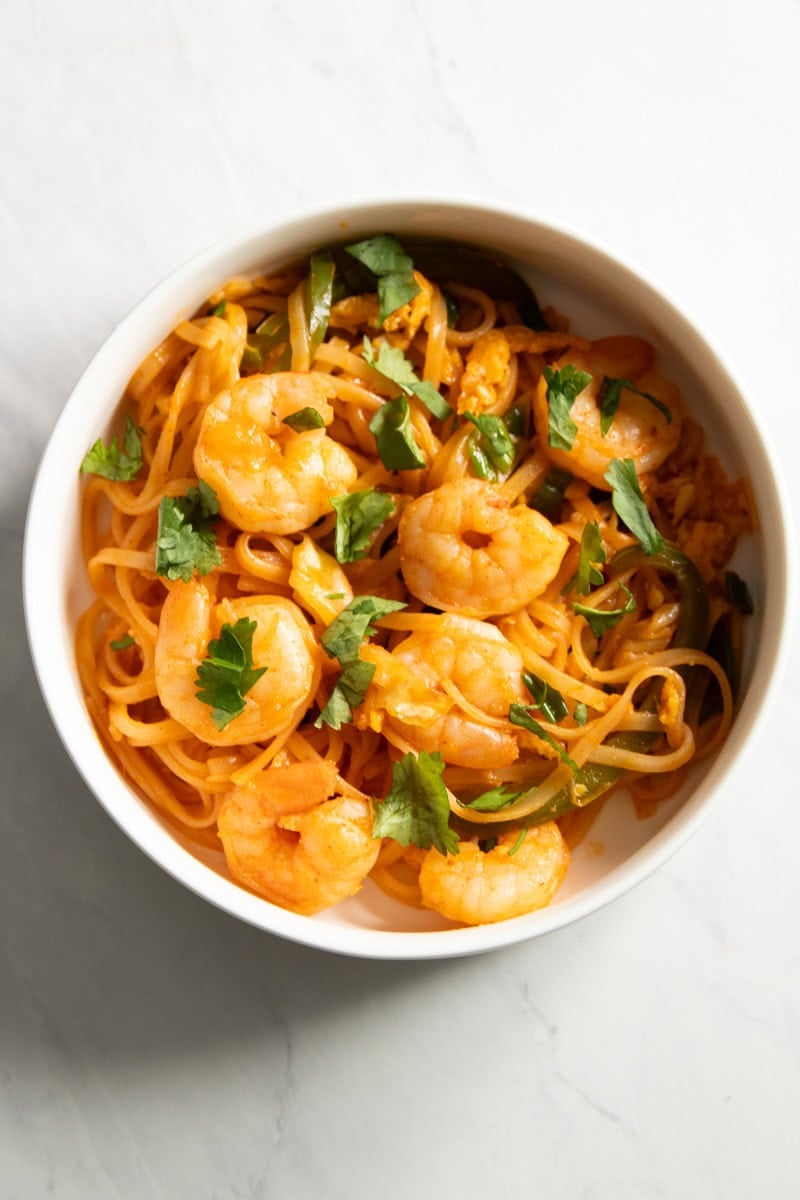
Instructions
This is a recipe that moves quickly; gather and prepare ingredients and equipment before starting for a smoother cooking process.
Check the rice noodle package instructions. If directed, start boiling the cooking water.
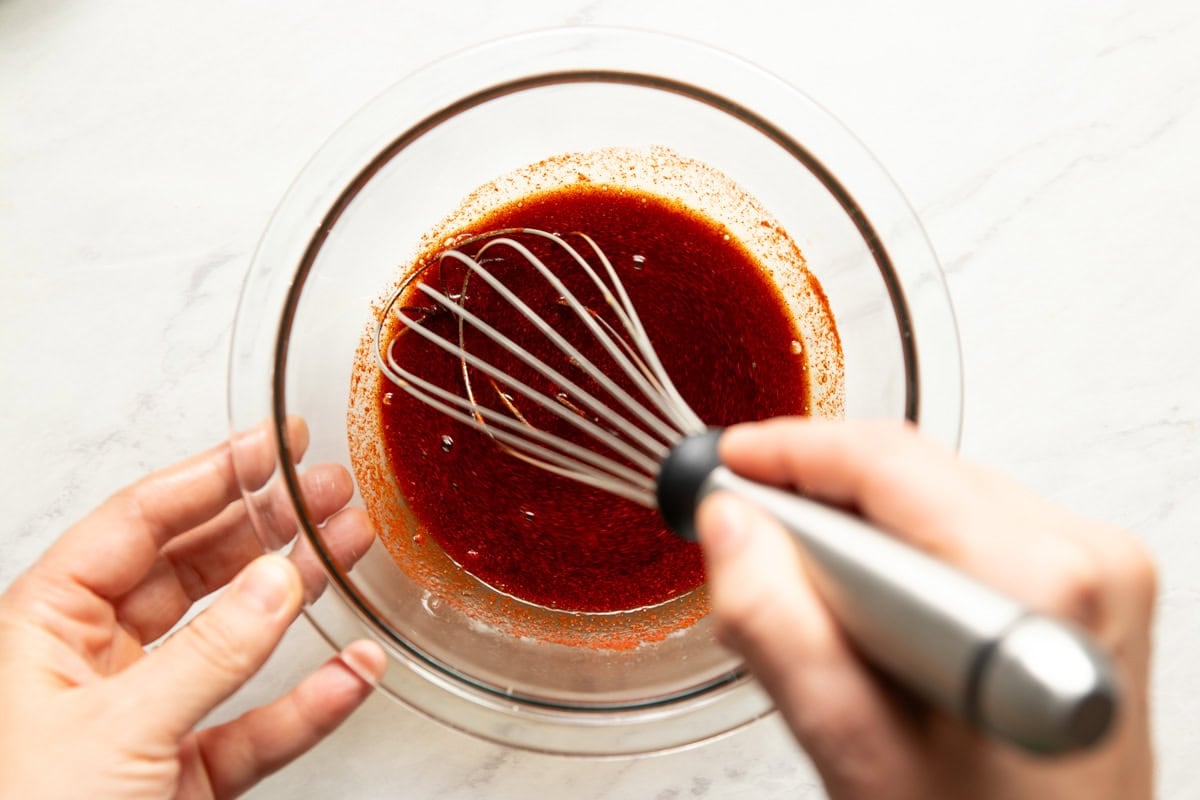
Whisk together sugar, rice vinegar, soy sauce (or tamari), fish sauce, and paprika in a small bowl.
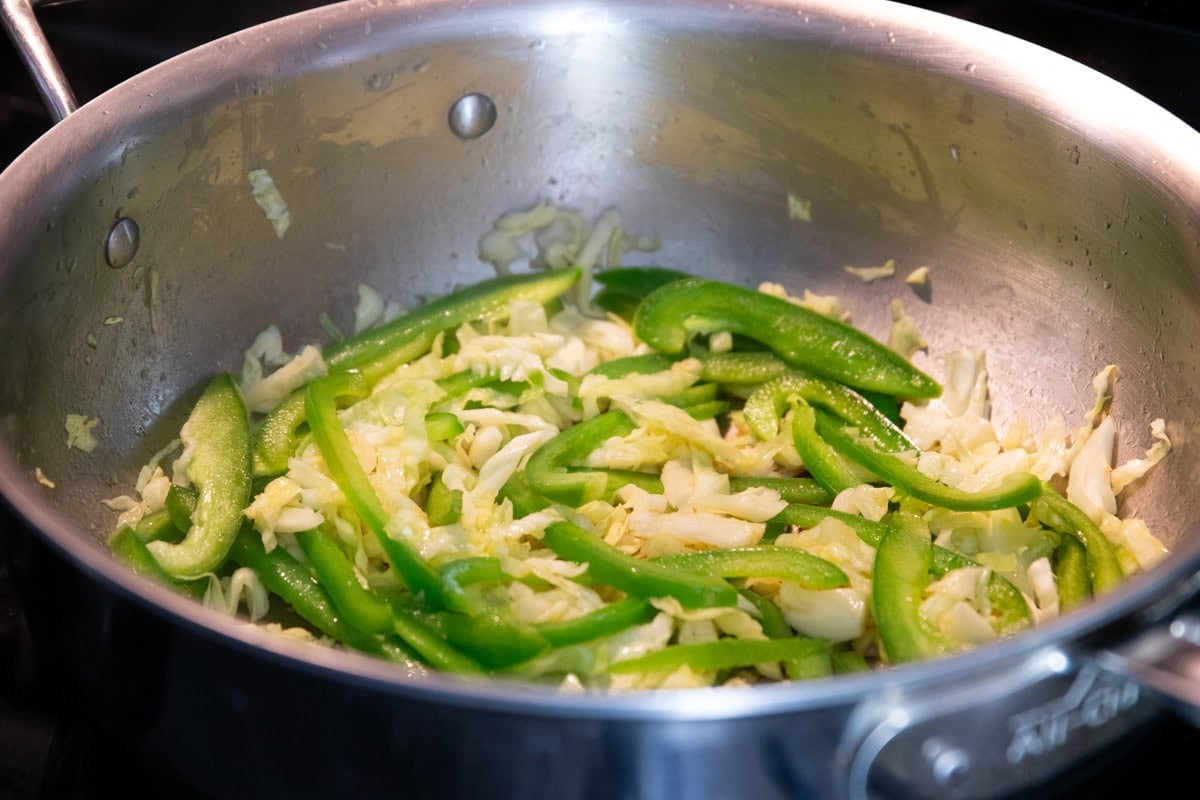
Heat 2 tablespoons garlic-infused oil in a large skillet over medium heat. Once the oil is hot, add the bell pepper slices and cabbage. Cook for 3 to 5 minutes or until the veggies start to soften.
While the peppers cook, prepare the rice noodles according to the package instructions. Drain.
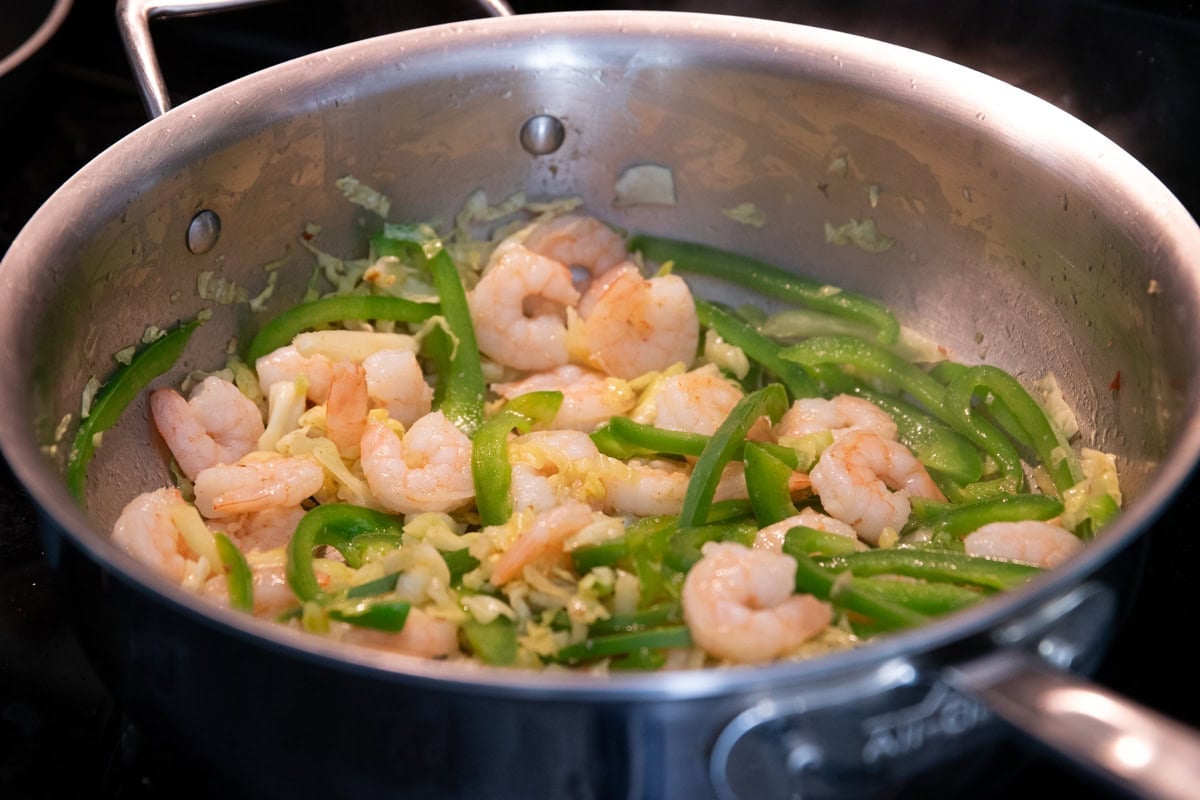
Once the peppers start to soften, add the shrimp to the skillet. Cook for 2 to 4 minutes or until the shrimp start to turn opaque pink and are almost cooked through. Add the sauce and cook for about 1 minute or until the shrimp are cooked and the sugar has dissolved. Reduce the heat to low.
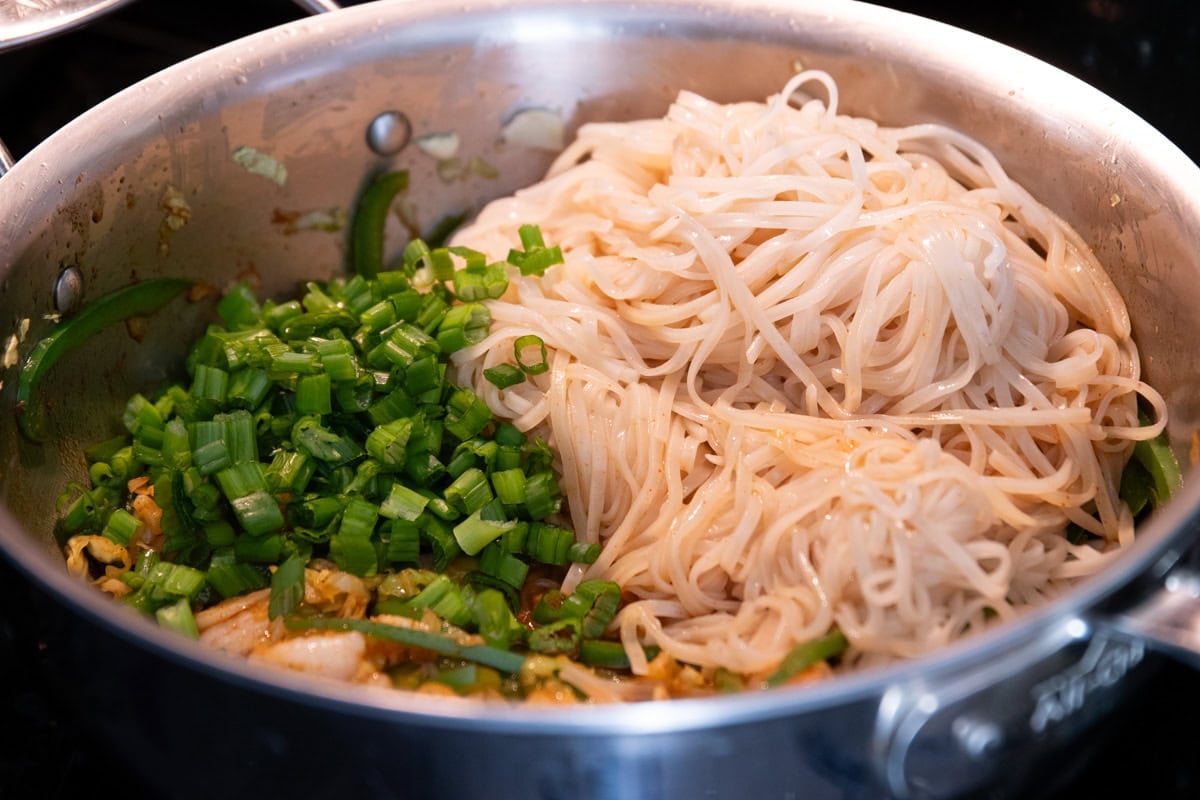
Stir in the noodles and green onion tops. Cook until everything is hot. Then, remove from the heat.
Optional: Heat the remaining 1 teaspoon of garlic-infused oil over medium-high heat in a small nonstick skillet. Once hot, add the egg and cook, scrambling with a silicone spatula, until done. Stir into the noodle mixture.
Serve warm, topped with optional cilantro leaves.
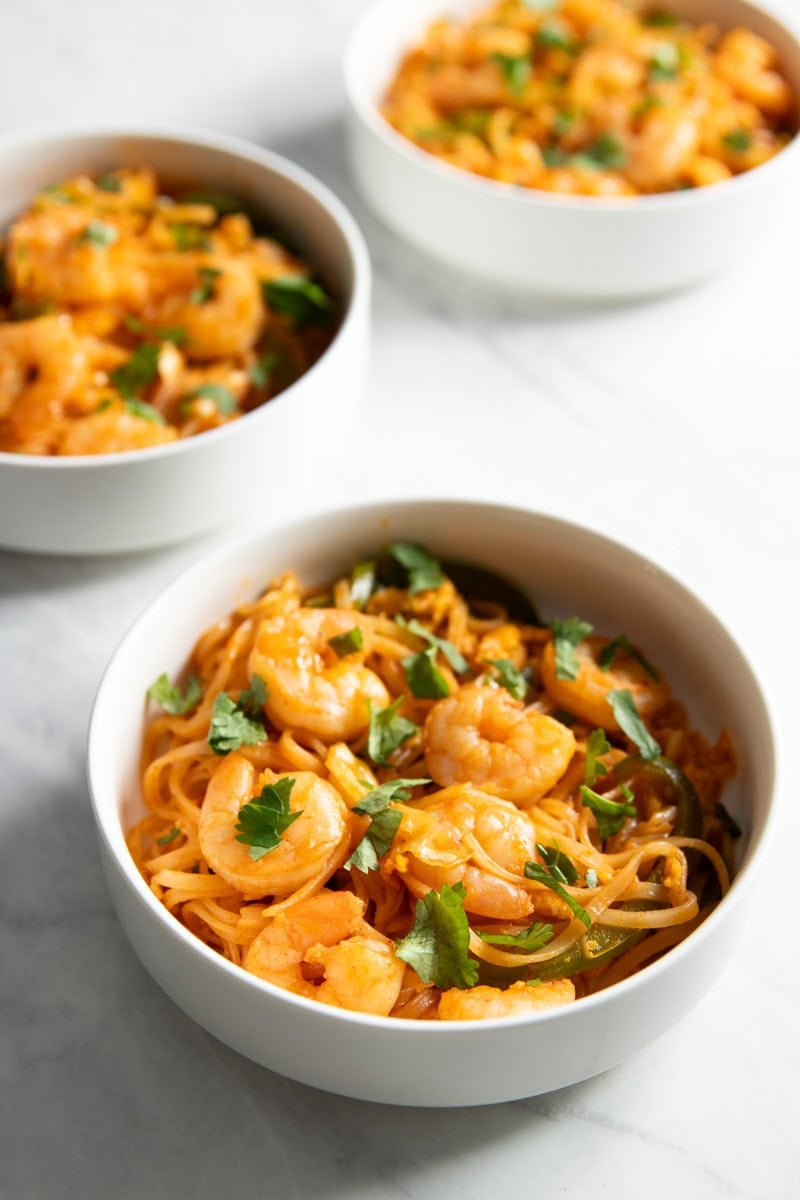
Similar recipes
- Low FODMAP Shrimp Stir Fry with Bell Peppers
- Low FODMAP Shrimp & Green Beans
- Low FODMAP Spicy Lemon Pasta with Shrimp
Recipe
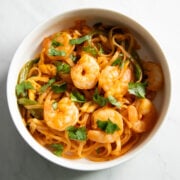
Low FODMAP Pad Thai with Shrimp
- Total Time: 30 minutes
- Yield: 4 servings
- Diet: Low Lactose
Description
This 30-minute Low FODMAP Pad Thai with Shrimp is a Thai restaurant-inspired dish featuring rice noodles, shrimp, a simple sauce, and FODMAP-friendly amounts of cabbage and green bell peppers.
Ingredients
- 8 ounces uncooked rice noodles, such as Thai Kitchen Brown Rice Noodles
- ¼ cup granulated sugar
- 2 tablespoons plain rice vinegar
- 2 tablespoons reduced-sodium soy sauce (or tamari for gluten-free)
- 1 tablespoon fish sauce
- 2 teaspoons ground paprika
- 2 tablespoons + 1 teaspoon garlic-infused olive oil, divided
- 1 medium (225 grams) green bell pepper, thinly sliced
- 1.5 cups shredded green cabbage
- 1 pound (454 grams) uncooked medium or large shrimp, peeled and deveined
- ½ cup sliced green onion tops (green parts only)
- 1 large egg, whisked - optional
- Chopped fresh cilantro leaves - optional garnish
Instructions
This is a recipe that moves quickly; gather and prepare ingredients and equipment before starting for a smoother cooking process.
- Check the rice noodle package instructions. If directed, start boiling the cooking water.
- In a small bowl, whisk together sugar, rice vinegar, soy sauce (or tamari), fish sauce, and paprika.
- Heat 2 tablespoons garlic-infused oil in a large skillet over medium heat. Once the oil is hot, add the bell pepper slices and cabbage. Cook for 3 to 5 minutes or until the veggies start to soften.
- While the peppers cook, prepare the rice noodles according to the package instructions. Drain.
- Once the peppers start to soften, add the shrimp to the skillet. Cook for 2 to 4 minutes or until the shrimp start to turn opaque pink and are almost cooked through. Add the sauce and cook for about 1 minute or until the shrimp are cooked and the sugar has dissolved. Reduce the heat to low.
- Stir in the noodles and green onion tops. Cook until everything is hot. Then, remove from the heat.
- Optional: Heat the remaining 1 teaspoon of garlic-infused oil over medium-high heat in a small nonstick skillet. Once hot, add the egg and cook, scrambling with a silicone spatula, until done. Stir into the noodle mixture.
- Serve warm, topped with optional cilantro leaves.
Notes
Low FODMAP Serving: One serving of this recipe (¼ recipe // about 1.5 cups // 225 grams) uses low FODMAP amounts of ingredients at the date of publication. Individual tolerance may vary, and low FODMAP servings may change. For more information on specific ingredients, please refer to the Monash FODMAP App or check out the "FODMAP Notes" section (above the recipe).
Fish sauce: Add more to taste, up to 2 tablespoons per serving.
- Prep Time: 15 minutes
- Cook Time: 15 minutes
- Category: Main Dish
- Method: Skillet, Stovetop
- Cuisine: Thai Inspired
Food safety
Some people develop IBS after having gastroenteritis (commonly referred to as a “stomach bug” or the “stomach flu”.) Practicing food safety is one way to help prevent many infections that can lead to gastroenteritis. Here are some food safety tips:
- Cook shellfish, including shrimp, to a minimum temperature of 145 °F (63 °C)
- Do not use the same utensils on cooked food that previously touched raw shellfish
- Wash hands after touching raw shellfish
- Don't leave food sitting out at room temperature for extended periods
- Never leave cooking food unattended
- Always have good ventilation when using a gas stove
See more guidelines at USDA.gov.
94
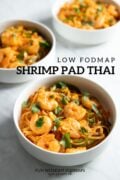
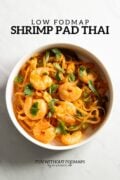

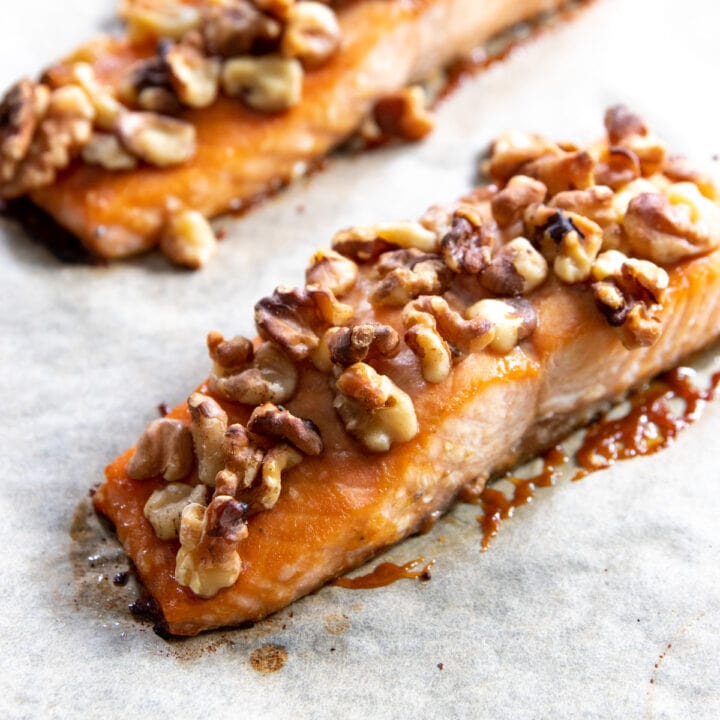

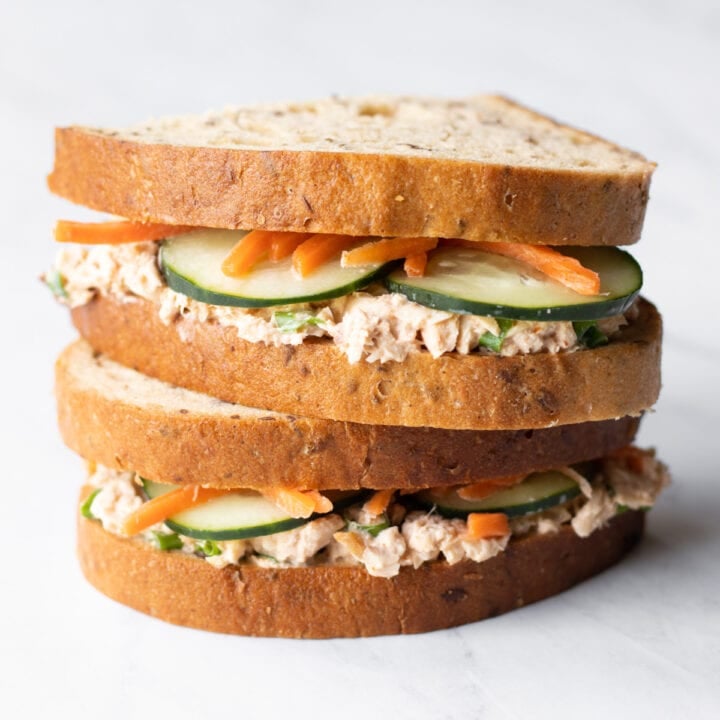
Matt says
I was a big fan of many recipes on this website except for this one.
I'm not sure what kind of fish sauce I was suppose to use, but not knowing what fish sauce was, I used the one that was available at the store. When I tasted the dish, it was awfully strong in taste and the more I ate ot, the worst it was... Finishing my plate, I got over the ingredients again and saw that the fish sauce I had has 1500mg of sodium per tbsp!!! So 1/4 cup is no less than 6g of salt right there, 7g with the added soy sauce.
I did regret not reading labels of new products 😉 I did not feel well that evening.
What kind of fish sauce you're using ?
Thank you!
Em Schwartz, MS, RDN says
Hi Matt, I appreciate you taking the time to share your feedback and I'm sorry to hear this wasn't a winner for you. I typically use Red Boat fish sauce when I cook with it. This recipe was designed after taking a Thai cooking class from a Thai chef, Supenn Harrison. In appreciation for her work, I used the amount of fish sauce based on her recommendations. I have learned to avoid demonizing the sodium content in other cultures' cuisines to strive for cultural appreciation but I also recognize the concerns many have regarding sodium content. It's a hard balance to strike. Fish sauce also has a flavor profile many in non-Southeast/East Asian cultures are not used to. As you are not the first person to have this feedback, I will modify this recipe to recommend starting with a smaller amount of fish sauce and adding more as needed to achieve preferred level of flavor/saltiness. Thanks again for the feedback! -Emily
Ciara Gossen says
Very good! Bright and robust flavours! The whole family enjoyed it which says a lot. I added a little fresh lime juice as is served it. Definitely will be added to the rotation. Thank you!
Angela says
Red peppers are no longer eat freely, they need portion control. I only mention it so someone new doesn't read your recipe and get misinformed. 3/7/2022
Em Schwartz, MS, RDN says
Thanks for your help, Angela! FYI to anyone reading - Monash has released a handful of retested food updates recently. Thanks for your patience and understanding as I update recipes and info to reflect these changes.
Rebecca Green says
I made this tonight and enjoyed it very much. I would suggest cooking the shrimp in a separate skillet and stir in at th end - by the time I was done with the recipe mine were overcooked and rubbery. I'm not a fan of bean sprouts so added in shredded carrots when the peppers were added to incorporate more veggie and then sprinkled with some chili oil for a little kick. I'm 3 weeks into FODMAP and appreciate this site and recipes. I'm definitely noticing my digestion issues clear now on this diet.
Sabrina Giordano says
The fish sauce stank out my whole kitchen but it tasted better than it smells! Lol but this tasted super authentic and was so easy to make!
Shannon says
I made this tonight with gf spaghetti noodles since I had them on hand. Two weeks into low fodmap and this was a delicious dinner my whole family loved. Thank you.
Em Schwartz, MS, RDN says
Thanks for taking the time to share, Shannon!
Cassie says
Is the old recipe/directions posted somewhere? I like that one better!
Em Schwartz, MS, RDN says
Hi Cassie, I will email a copy to the (hidden) email address you submitted with this comment. As a heads up, the older version (with red bell pepper) may be higher in excess fructose using Monash's updated serving size information. If you tolerate it fine and like it better, great! Just want to be transparent. -Emily
Diane says
This was great, the first time I made it as is but along with having to eat FODMAP friendly, I am also diabetic so the second time I left out the sugar and it was still great! What a versatile recipe! Thanks so much! BTW the whole family loved it!
Em Schwartz, MS, RDN says
Thanks for sharing, Diane! Glad you enjoyed it and were able to modify it to meet your needs.
Marilyn says
I made this last evening for dinner. I used Rice Ramen and cooked it for the 2 minutes in the boiling water. This turned out great. I was a little afraid of the sugar, but oh well. It is a twist on pad thai. I'm used to the peanut sauce version, but will definitely make this again. It was a big hit! I am so thrilled that I found this website as I am new to Fodmap thing. Dr. has me doing it for 4 weeks.
Em Schwartz, MS, RDN says
Glad to hear you enjoyed this twist on pad thai. Thanks for sharing, Marilyn!
Tracy Pringle says
I made this recipe exactly as written (minus green onion because of allergies) and it was FANTASTIC! We haven't ordered pad thai since I discovered this one about a month ago - and we were ordering every week! Thanks for sharing this - it's delish!
Emily says
I'm so glad you enjoyed it, Tracy! Thank you for taking the time to share your thoughts!
Donna Bougourd says
Loved it loved it loved it!
Emily says
So glad to hear, Donna! Thanks for sharing!
Marissa says
Yum! Pad Thai has become one of my new favorites dishes to make and this recipe is absolutely delicious! Thanks for sharing!
Emily says
Thanks, Marissa! So glad you enjoy this recipe as much as I do! 🙂
MacKenzie says
This recipe did NOT turn out for me at all. The noodles never softened in cold water so what was supposed to be a quick recipe turned into quite a bit of time in the kitchen. The sauce was okay...way too much paprika. I was really wanting Pad Thai and went to the store specifically to get ingredients for this recipe. I was super disappointed.
Emily says
Hi MacKenzie, I'm sorry to hear that this didn't work out for you. Do you remember what kind of rice noodles you tried? Traditional rice noodles should soften in the water and then continue to soften as they cook. Pad Thai recipes vary greatly, some are more sauce-based, others are drier, like this one. It does call for a lot of paprika, but this is the way I learned how to make it from a local Thai cooking class. My family and I personally love the taste of it, but we're all unique and have different preferences. I'm sorry this didn't work out for you and I appreciate the feedback.
Raegan says
I made this for lunch today- very good! I think it will be one of my go-to comfort meals. I really like that peanuts/peanut butter was not included in the recipe. Both cause stomach trouble for me. I only had tiny shrimp but it still tasted great!
Emily says
Thanks for the feedback, Raegan!
Gabby says
Ahhhhh!!!! This recipe is amazing! Thank you so much for posting it. Pad Thai is my absolute favorite food and it’s so hard craving it when you’re on the low fodmap diet. This was seriously just as good, if not better as my favorite restaurant Pad Thai 🙂
Emily says
Thank YOU, Gabby! I love Pad Thai, too! Thrilled to hear you enjoyed it!
Kristina says
Hey Emily! Brand new to the fodmap diet, and I was having trouble coming up with recipes to make. This diet is very exclusive to many common foods. I love to cook and bake, so this has all been a challenge. There are not many blogs focused on this and I appreciate finding yours! Just made this for dinner for my husband and I, we love asian food, and it was SO good! Thanks for your recipes 🙂
Emily says
Hi Kristina! Thank you for sharing!! Thai food is my absolute favorite, so I really enjoy this dish. I'm thrilled you liked it, too! 🙂